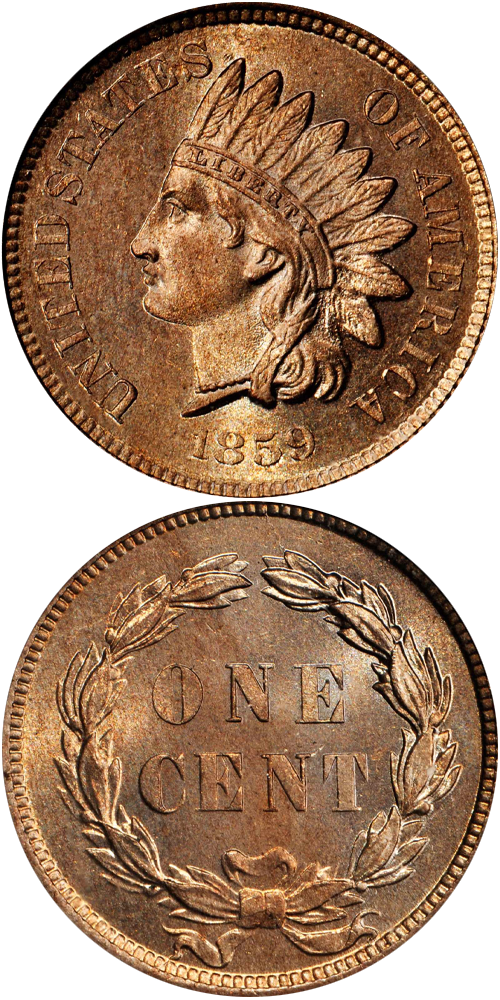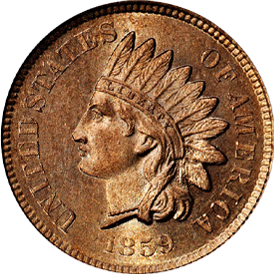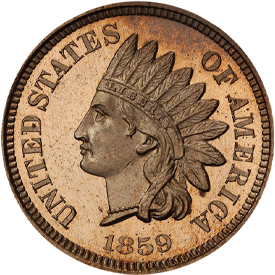Designed by: James Barton Longacre
Issue Date: 1859
Composition: 88% copper, 12% nickel
Diameter: 19 mm
Weight: 4.66 grams (72 grains)
Edge: Plain
Business Strike Mintage: 36,400,000
Proof Mintage: 800 (estimated)
Following a pattern coinage in 1858, the Indian cent motif was used for circulating coinage in 1859, during which year 36,400,000 were struck. The obverse depicts a stylized Indian facing left, wearing a feathered headdress upon which is a band inscribed LIBERTY. To the left is UNITED STATES, and behind the head appears OF AMERICA. The date is below. The reverse employed on the 1859 cent shows a narrow wreath of laurel leaves enclosing the word ONE CENT. Although the laurel wreath was discontinued for cent coinage after 1859, Longacre brought it to life later for an adaptation used on the reverse of the nickel three-cent piece (minted 1865-1889).
Examples of the 1859 Indian cent are readily available in all grades from Good through AU. Uncirculated coins are scarcer, and superb Uncirculated pieces are quite elusive. Proofs were made for collectors, to the extent of an estimated 800 coins, and are occasionally available, although superb Proofs are decidedly rare.
Further Reading
The search for a replacement for the unsatisfactory (for striking purposes) Flying Eagle cent led to the production of several patterns. These are of two main obverse types, those with a small and skinny-looking eagle and those with an Indian. The Indian appears in full headdress and is identical to that actually used for later coinage. In addition, regular flying eagle Proof cent dies were used for the obverses of certain patterns, probably to produce delicacies for collectors.
The series of 1858 pattern cents is an extensive one, for the skinny flying eagle, regular flying eagle, and Indian cent obverse dies were produced in combination with several different reverses. Sets of 12 different 1858 pattern cents were sold by Mint officials to interested persons. While most such groupings have been long since dispersed, I had the pleasure of acquiring an intact set from the firm of David Bullowa, of Philadelphia in the early 1950s.
Perhaps the most interesting and significant of all 1858 patterns is the piece catalogued in Dr. J. Hewitt Judd's United States Patterns as J-208, the so-called 1858 Indian cent. This piece has an Indian head on the obverse and a laurel wreath on the reverse and is identical, except for the date, to a regular issue cent of 1859. At one time I became enamored of this particular variety and set about hoarding them. I was able to identify a number of different die varieties of this particular issue, indicating that they must have been struck over a period of time, possibly at later intervals (as were 1856 flying eagle cents), in order to satisfy the demand from collectors and to provide a little extra, but quite unofficial, income to Mint employees. All specimens struck were in Proof condition; no Uncirculated pieces were made.
The Indian cent design met with immediate favor, and in 1859 cents of this style were first produced for circulation. The 1859 design used a laurel wreath without a shield at the top for the reverse motif.
Later in the same year it was decided to redesign the reverse, so several hundred pattern issues were made using an oak wreath with a shield at the top. Although a very few pieces were made in Proof, hundreds of these were made in Uncirculated grades, presumably intended for distribution to congressmen and other influential officials. Exactly how these were actually distributed, I don't know, but it is apparent that most of them went to collectors. Circulated specimens are exceedingly rare. Because this pattern issue was struck in Uncirculated or business strike format, with frosty mint luster, a grade rare for a pattern (most patterns are Proofs), a number of people have considered this to be a "regular issue." As the oak wreath with shield design was not officially used until 1860, a better term would be "transitional pattern." However, there is no doubt that the piece is interesting and significant, and owning one is a desire of many collectors of small cents. Likewise, ownership of an 1858 Indian cent has always been popular. Both of these pieces, the 1858 and 1859 transitional issues, have the same status and claim to collectability as the 1856 Flying Eagle cent.
1859 represents the only year Indian cents with the laurel wreath reverse were made for general circulation. Thus, these cents are isolated as necessities for a complete type set of United States coinage. Specimens are readily available in lower grades, somewhat scarce (reflective of the demand for them) in Uncirculated condition, and quite elusive in Proof. Only a few hundred Proofs survive, many of which are impaired.








